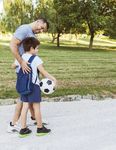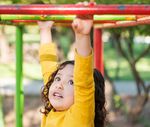RETURNING TO SCHOOL AFTER A CONCUSSION - A Fact Sheet for School Professionals - CDC
←
→
Page content transcription
If your browser does not render page correctly, please read the page content below
RETURNING TO SCHOOL
AFTER A CONCUSSION
A Fact Sheet for School Professionals
What role do I play in helping a student
What is a return to school after a concussion?
Concussion? Each year hundreds of thousands of K-12 students
A concussion is a type of traumatic sustain a concussion as a result of a fall, motor-vehicle
brain injury (TBI) that results from a crash, collision on the playground or sports field,
bump, blow, or jolt to the head (or by or other activity. Most will have a good recovery.
a hit to the body) that causes the head However, school professionals, like you, will often be
and brain to move rapidly back and challenged with helping return a student to school
forth. This sudden movement can cause who may still be experiencing concussion symptoms—
the brain to bounce around or twist symptoms that can result in learning problems and
in the skull, stretching and damaging poor academic performance.
the brain cells and creating chemical
Knowledge of a concussion’s potential effects on a
changes in the brain.
student, and appropriate management of the return-
While some research shows that the to-school process, is critical for helping students
young brain can be resilient, it may also recover from a concussion.
be more susceptible to the chemical
changes that occur in the brain after That’s where you come in. This fact sheet provides
a concussion. These changes can lead steps that school professionals can take to help
to symptoms affecting the student’s facilitate a student’s return to school and recovery
cognitive, physical, emotional, and after a concussion. It emphasizes the importance of
sleep functions. a collaborative approach by a team that includes not
only school professionals, but also the student’s family
Concussions affect people differently.
and the healthcare provider(s) managing the medical
Most students will have symptoms that
aspects of the student’s recovery.
last for a few days or a week. A more
serious concussion can last for weeks,
months, or even longer.How can a concussion affect learning?
What to Look for
After a Concussion
The effects of concussion on a student’s return-
to-school experience are unique to each student.
When students return to school
In most cases, a concussion will not significantly
after a concussion, school
limit a student’s participation in school. However,
professionals should watch for:
in some cases, a concussion can affect multiple
aspects of a student’s ability to participate, learn,
• Increased problems paying and perform well in school.
attention or concentrating
In turn, the experience of learning and engaging in
• Increased problems academic activities that require concentration can
remembering or learning new actually cause a student’s concussion symptoms to
information reappear or worsen. Given this connection and the
• Longer time needed to way concussion effects can vary across students,
completetasks or assignments academic adjustments need to be tailored to each
student’s specific circumstances.
• Difficulty organizing tasks or
shifting between tasks
• Inappropriate or impulsive
behavior during class When is a student ready to return to
• Greater irritability school after a concussion?
• Less ability to cope with stress
• More emotional than usual A student with a concussion should be seen by
a healthcare provider experienced in evaluating
• Fatigue for concussion. A healthcare provider can make
decisions about a student’s readiness to return to
• Difficulties handling a
school based on the number, type and severity of
stimulating school environment
symptoms experienced by the student.
(lights, noise, etc.)
The healthcare provider should also offer guidance
• Physical symptoms (headache,
about when it is safe for a student to return to
nausea, dizziness)
school and appropriate levels of cognitive and
physical activity. Once a healthcare provider has
given permission for the student to return to the
classroom, school professionals can help monitor
him/her closely.
With proper permission, school professionals
can confer on their observations and share
those observations with the family and other
professionals involved in the student’s recovery.
2 | Returning to School After a Concussion: A Fact Sheet for School ProfessionalsWho should be included as part of the team supporting the student? Providing appropriate support for a student returning to school after a concussion requires a collaborative team approach. The team, sometimes referred to as the “Concussion Management Team,” may include: The Student The affected student should be “in the loop” and encouraged to share his/her thoughts about how things are going, and symptoms he or she is experiencing. The student should receive feedback from the rest of the team that is appropriate to his/her age, level of understanding, and emotional status. Parents / Guardians Parents and guardians need to understand what a concussion is, that medical attention is required, that most students will get better, the potential effects on school learning and performance, and the importance of following guidance from their student’s healthcare provider in order to ensure the most rapid and complete recovery possible. Other Caregivers (e.g., sports coaches, afterschool or day care providers) People who care for or are responsible for a student after school hours can play an important role in monitoring participation in afterschool activities and observing any changes in symptoms. Physician and/or Other Healthcare Providers Healthcare providers involved in the student’s diagnosis and recovery should provide an individualized plan for a student returning to school to help manage cognitive and physical exertion following a concussion. As a student recovers, healthcare providers can help guide the gradual removal of academic adjustments or supports that may be instituted as part of the recovery process. School Nurse Periodic monitoring of the student’s symptoms by the school nurse should continue as long as symptoms are present. The school nurse is also a resource for other school professionals who may have questions about their own observations and may also be an important liaison to parents or concussion experts within the community. All Teachers Interacting with the Student (including the physical education teacher) Teachers can often help observe changes in a student, including symptoms that may be worsening. Teachers are also in a position to interact regularly with the student’s parents, providing a channel to obtain and share information with them about the student’s progress and challenges. 3 | Returning to School After a Concussion: A Fact Sheet for School Professionals
School Psychologist
and/or School Counselor
School psychologists and/or school counselors can often With proper
help with identifying services and resources to help the permission, members
student and parents or guardians and facilitate getting of the school team
those services and resources for them, including a 504 should meet together
Plan or IEP. School psychologists can also help assess on a regular basis to:
a student’s current functioning and his/her academic • Share observations and any new
needs for full recovery. information obtained from the
family or healthcare provider.
• Work with the family to develop
Speech Language Pathologists an appropriate program and
Speech-language pathologists can help monitor or timeline to meet the student’s
identify students with a concussion who are having needs and explain as necessary
trouble in the classroom, as well as changes in how a the reasons for the resulting plan.
student is communicating or interacting with others. • Continually reassess the student
Speech-language pathology services may include for symptoms and progress
testing, providing classroom strategies or modifications, in healing. This information
and direct services to a student. can help the team to make
adjustments to the plan.
School Principal
or Other School Administrators
The school principal or administrator should appoint the internal members of the team as well as a “case
manager” to ensure adequate communication and coordination within the team. The administrator will
also be responsible for approving any adjustments to the student’s schedule and communicating policies
on responding to students who have had a concussion (e.g., return-to-play policy).
If the student is an athlete, either inside or outside of
school, the Concussion Management Team should also
include coaches and other athletic department staff
(e.g., certified athletic trainer). Remember, a student
with a concussion should NEVER return to sports,
PE class, or other physical activity until a healthcare
provider with experience in evaluating for concussion
says the student is OK to return to play.
Comprehensive information and training modules for
coaches and healthcare providers are available from the
HEADS UP initiatives at www.cdc.gov/HEADSUP.
4 | Returning to School After a Concussion: A Fact Sheet for School ProfessionalsIt is important to identify someone on the Concussion Management Team who will function as a point
of contact, such as a school nurse, school psychologist, school counselor, speech pathologist, teacher, or
other identified school professional. This person will have the role of advocating for the student’s needs
and serve as the primary point of contact with the student, family, and all members of the team. Find a
flexible set of CDC HEADS UP to Schools materials at: www.cdc.gov/HEADSUP.
How can understanding concussion symptoms help with identifying a
student’s individual needs?
A school professional can best support a student’s return to school and recovery by understanding
possible concussion effects and providing the student with needed accommodations and support.
Understanding concussion symptoms can help the student and members of the team identify individual
needs of the student, monitor changes, and with proper permission, take action when necessary.
This will help facilitate a full recovery and discourage students from minimizing the symptoms due to
embarrassment, shame, or pressure to return to activities.
Signs & Symptoms of a Concussion
Signs Observed by
Parents or Guardians Symptoms Reported By Students
• Appears dazed or stunned Thinking/Remembering Emotional
• Is confused about events • Difficulty thinking clearly • Irritable
• Difficulty concentrating or • Sad
• Answers questions slowly
remembering • More emotional than usual
• Repeats questions • Feeling more slowed down • Nervous
• Can’t recall events prior to • Feeling sluggish, hazy, foggy,
hit, bump, or fall or groggy Sleep*
• Can’t recall events after • Drowsy
hit, bump, or fall Physical • Sleeps less than usual
• Loses consciousness (even • Headache or “pressure” in head • Sleeps more than usual
briefly) • Nausea or vomiting • Has trouble falling asleep
• Balance problems or dizziness
• Shows behavior or
personality changes • Fatigue or feeling tired *Only ask about sleep
• Blurry or double vision symptoms if the injury
• Forgets class schedule or • Sensitivity to light or noise occurred on a prior day.
assignments
• Numbness or tingling
• Does not “feel right”
5 | Returning to School After a Concussion: A Fact Sheet for School ProfessionalsSigns and symptoms of concussion generally show up soon after the injury. However, a concussion is an evolving injury. The full effect of the injury may not be noticeable at first and some symptoms may not show up for hours or days. In the classroom, concussion symptoms may translate into a variety of challenges with learning. Cognitive symptoms may result in problems with speed of reading, difficulties doing multi-step math problems, problems maintaining consistent attention throughout the class, and/or distractibility. Students’ complaints about physical symptoms such headache, fatigue or increased sensitivity to the lights in the classroom or the noise in the hallways and cafeteria may impair the effectiveness of their learning. Problems with emotional control can also be evident. The student can become more easily irritated or agitated or may feel overwhelmed and frustrated by their learning challenges. These different symptoms can impact the student’s overall school performance. What role does rest play in a student’s recovery? Most students will be advised by a healthcare provider to rest for no more than 2-3 days after the injury. This is when symptoms, like headaches or fatigue, are usually most severe. Like recovering from some other injuries, students recovering from a concussion may need to rest. But they don’t just need physical rest. For their brains to heal, they also need cognitive rest. This includes giving a brain a break from activities that include a lot of concentration. Too much cognitive activity following a concussion may be detrimental to a student’s recovery. The goal of rest following a concussion is to limit a student’s activities to a level that is tolerable and does not worsen or result in the reemergence of concussion symptoms. 6 | Returning to School After a Concussion: A Fact Sheet for School Professionals
Rest doesn’t mean
keeping a child in a dark
room all day. But it may
include limiting certain
activities, like:
• Using a computer, tablet, or phone.
• Driving
• Watching TV
• Studying for or taking an exam
• Reading
• Playing video games.
It is important to explain
to students that ignoring
concussion symptoms and
trying to “tough it out” often
makes symptoms worse and
can make recovery take longer,
sometimes for months.
Tolerance for cognitive activity
increases as the student recovers, but
the rate of recovery may vary from
one student to another. For example,
three days after their injury one
student may be able to read for 30
minutes before experiencing fatigue,
headache, and reduced concentration;
whereas, another student may be able
to tolerate only 10 minutes of this same
activity three days following the injury.
Regular monitoring of symptoms,
including input from the student, is
critical in any return-to-school plan.
7 | Returning to School After a Concussion: A Fact Sheet for School ProfessionalsIt is normal for students to feel
frustrated, sad, embarrassed,
and even angry.
Talk with the student about
these issues and offer support
and encouragement.
8 | Returning to School After a Concussion: A Fact Sheet for School ProfessionalsHow can school professionals help identify
problems and needs?
Based on the identification of symptoms and an analysis
of how the student responds to various activities,
interventions that are tailored to the specific needs of the
student can be identified and implemented.
To start, identify the types of
symptoms the student is experiencing.
Next, try to identify specific factors
that may worsen the student’s
symptoms so steps can be taken to
modify those factors. For example:
• Do some classes, subjects, or tasks appear to pose
greater difficulty than others? (compared to pre-
concussion performance)
• For each class, is there a specific time frame after
which the student begins to appear unfocused or
fatigued? (e.g., headaches worsen after 20 minutes)
• Is the student’s ability to concentrate, read or work
at normal speed related to the time of day? (e.g., the
student has increasing difficulty concentrating as
the day progresses)
• Are there specific things in the school or classroom
environment that seem to distract the student?
• Are any behavioral problems linked to a specific
event, setting (bright lights in the cafeteria or loud
noises in the hallway), task, or other activity?
Importantly, if a student has a history of concussions, a medical condition at the time of the concussion
(such as a history of migraines), or developmental disorders (such as learning disabilities and ADHD), it
may take longer to recover from the concussion. Anxiety and depression may also prolong recovery and
make it harder for the student to adjust to the symptoms of a concussion.
It is normal for students to feel frustrated, sad, embarrassed, and even angry because they cannot keep
up with their schoolwork or participate in their regular activities, such as driving or sports. A student
may also feel isolated from peers and social networks. Talk with the student about these issues and offer
support and encouragement. In consultation with the student’s healthcare provider, and as the student’s
symptoms decrease, the extra help or support can be removed gradually.
9 | Returning to School After a Concussion: A Fact Sheet for School ProfessionalsSome Strategies for Addressing Concussion Symptoms at School
(Please note: these strategies will vary based on the student’s age, level of understanding, and emotional status)
Cognitive
• Concentrate first on general cognitive skills, • Allow extra time for test/in-class
such as flexible thinking and organization, assignment completion. Help the
rather than academic content. student create a list of tasks and/
or daily organizer.
• Focus on what the student does well and
expand the curriculum to more challenging • Assign a peer to take notes for the
content as concussion symptoms subside. student.
• Adjust the student’s schedule as needed • Allow the student to record classes.
to avoid fatigue: shorten day, time most • Increase repetition in assignments
challenging classes with time when student to reinforce learning.
is most alert, allow for rest breaks, reduced
• Break assignments down
course load.
into smaller chunks and offer
• Adjust the learning environment to reduce recognition cues.
identified distractions or protect the student
• Provide alternate methods for the
from irritations such as too-bright light or
student to demonstrate mastery,
loud noises.
such as multiple-choice or
• Use self-paced, computer-assisted, or audio allowing for spoken responses to
learning systems for the student having questions rather than long essay
reading comprehension problems. responses.
Behavioral / Social / Emotional
• If the student is frustrated with failure in one •
area, redirect him/her to other elements of
the curriculum associated with success.
• Provide reinforcement for positive behavior
as well as for academic achievements.
• •
•
•
• Remove a student from a problem situation,
but avoid characterizing it as a punishment
and keep it as brief as possible.
10 | Returning to School After a Concussion: A Fact Sheet for School ProfessionalsWhen symptoms
persist: What types
of formal support
services are available?
For most students, only temporary,
informal, academic adjustments
are needed as they recover from
a concussion. However, a variety
of formal support services may be
available to assist a student who is
experiencing a prolonged recovery.
These support services may vary widely among states and school districts. The
type of support will differ depending on the specific needs of each student.
Some of these support services may include:
• Response to Intervention Protocol (RTI): An RTI may be used for students who need academic
adjustments for an extended period and/or need to increase the level of a particular intervention.
An RTI allows for a multi-step, targeted approach that school professionals can use to monitor a
student’s progress through increasing levels of an intervention. At each intervention level, a school
professional assesses the students to determine whether additional instruction or support is needed.
• 504 Plan: Students with persistent symptoms and who require assistance to be able to participate
fully in school, may be candidates for a 504 plan. A 504 plan will describe modifications and
accommodations to help a student return to pre-concussion performance levels. For example,
a student recovering from a concussion might receive environmental adaptations, temporary
curriculum modifications, and behavioral strategies.
• Individualized Education Plan (IEP): Students with certain classifications of disability that adversely
impact educational performance may be eligible or an IEP. These students generally require
significant help to access the curriculum. This help may include adjusting the student’s workload,
adjusting methods or pace of instruction, or allowing the student to work in an environment other
than an inclusive classroom. The majority of students with a concussion will not require an IEP;
however, a small percentage of students with more chronic cognitive or emotional disabilities may
require this level of support.
11 | Returning to School After a Concussion: A Fact Sheet for School ProfessionalsBe sure to check
with your national
association or
school district
to learn about
existing resources
or policies on
returning students
to school after a
concussion.
Find CDC HEADS UP to Schools
materials at:
www.cdc.gov/HEADSUP
External Expert Reviewers/Contributors: Susan Davies,
MD; Gerry Gioia, PhD; Wayne Gordon, PhD; Mark Halstead,
MD; Karen McAvoy, PsyD; and Eric Rossen, PsyD
January 2021
To learn more about concussion go to
www.cdc.gov/HEADSUP or call 1-800-CDC-INFOYou can also read



























































